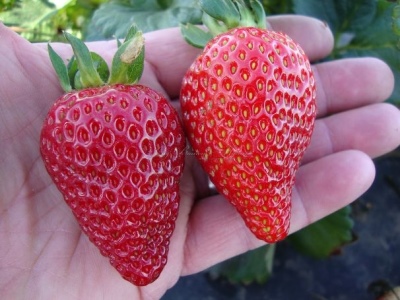
- Authors: Consortium of Italian nurseries
- Taste: sweet with sourness
- The size: large
- Weight: 35-40 gr
- Yield rate: high
- Yield: from 0.8 to 1 kg per bush
- Repairability: Yes
- Ripening terms: early
- Description of the bush: medium density
- Berry color: bright red
The Linos variety attracted gardeners with its ability to produce large berries and bear fruit abundantly. Today it is the most popular variety. And also its fruits have good transportability.
Breeding history of the variety
The variety was obtained by crossing two species. Bred in 2005 by the Consortium of Italian Nurseries. The variety was tested in countries with continental climates.
Description of the variety
Linosa is a medium-sized plant of medium density. The height of the bush is 30 cm. The leaves are dark green, slightly wrinkled. The multi-flowered peduncles are long, located at the same level with the leaves. The culture has a high ability to formulate. The main advantage is constant flowering over time.
Ripening terms
Strawberry belongs to the remontant variety with early ripening.
Growing regions
The variety has proven itself well for cultivation in Russia, Belarus and Ukraine.
Yield
The crop has a high yield and bears fruit 2 times per season. The first time it ripens 7 days earlier than the earliest varieties. The second wave begins in the middle of summer and ends with the arrival of the first frost. During the season, up to 1 kg of strawberries are harvested from one bush. The first crop ripens after the first month from the beginning of flowering.
Berries and their taste
The berries are large, bright red, conical in shape. The berry mass is 35-40 grams. It has a light strawberry aroma and sweet taste, with a predominance of slight sourness. The pulp is red, very sweet and juicy. The fruits retain their original shape and taste even after very long storage.
Growing features
It is recommended to plant crops in August, before that it is necessary to fertilize the soil. The distance between the rows of bushes should be 30-35 cm. A seedling is placed in a hole up to 5 cm deep and sprinkled with earth. Immediately after planting, the bushes must be watered with warm water. And also regular watering should be carried out until the plant is completely stronger and takes root.
And also planting can be done in the fall - before the onset of the first frosts, in the spring - after the soil has completely warmed up, in the summer - at the end of July.
When growing strawberries, you need to know that the variety gives a lot of whiskers. They need to be cut in time so that the berries are not crushed and the yield level does not decrease.




Site selection and soil preparation
The culture must be planted in places where partial shade will be present, as well as in parts of the site protected from the wind. Before planting, you need to dig up the soil well so that it is loose. Remove weeds.

Pollination
The culture has a bisexual type of flowers. Additional pollination is not required.
Top dressing
The variety is well adapted to poor soils, but in order to increase yields, it is necessary to constantly fertilize the soil. It is recommended to feed the crop with fertilizers based on potassium, phosphorus and iron.

One of the important techniques in strawberry care is feeding. Regular fertilization guarantees a rich harvest. There are several different ways to feed strawberries, and each of them is designed for a specific period of plant development. During flowering, fruiting and after it, feeding should be different.
Frost resistance and the need for shelter
Strawberry Linos is a fairly winter-hardy crop. But in regions with cold winters and little snow cover, as well as where spring frosts are possible, it is recommended to cover the bushes with agrotechnical cloth.

Diseases and pests
The culture has a high resistance to powdery mildew. Medium resistant to brown and white spots. And also it is affected by some insects.
Spider mite. Affects the lower part of the leaves.
Slobber. It does harm by sucking the juice from the core, as a result of which the bush dries up.
Raspberry weevil.
Stem nematode.

Strawberries are often subject to many dangerous diseases that can seriously undermine its condition. Among the most common are powdery mildew, gray mold, brown spot, anthracnose, and verticillosis. Before buying a variety, you need to inquire about its disease resistance.
Reproduction
The recommended breeding method is a mustache. It is best to separate the mustache from the two-year-old bushes that have yielded the most crops. The mustache should be spread between the rows of strawberries.After the formation of leaves on them, the whiskers take root in the ground. When rooting, it is necessary to water the soil, cut off the ends of the whiskers so that only the first outlet remains.

Review overview
Reviews of people growing the culture of the Linos variety were divided. Some believe that the plant is too demanding for growing conditions and has a tendency to frequent diseases. Others, on the contrary, are satisfied with the high yield, the taste of the berries and the ease of caring for the plant.


















































































